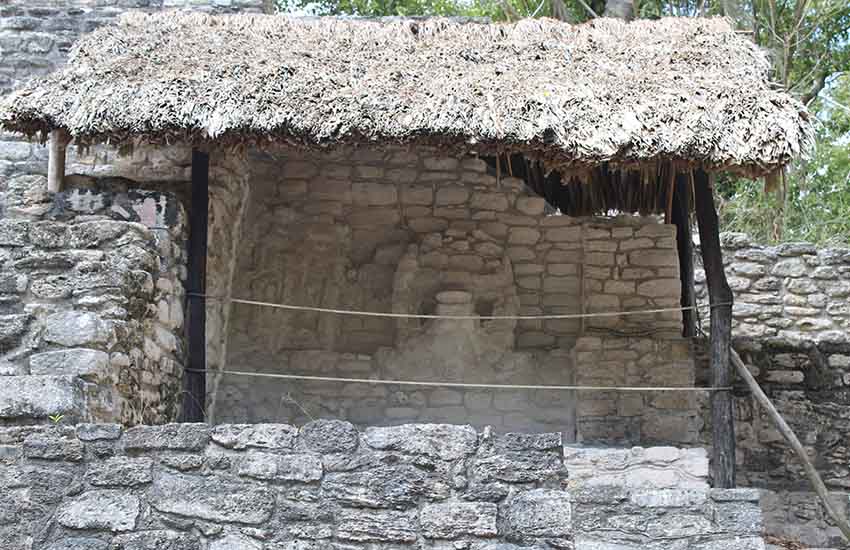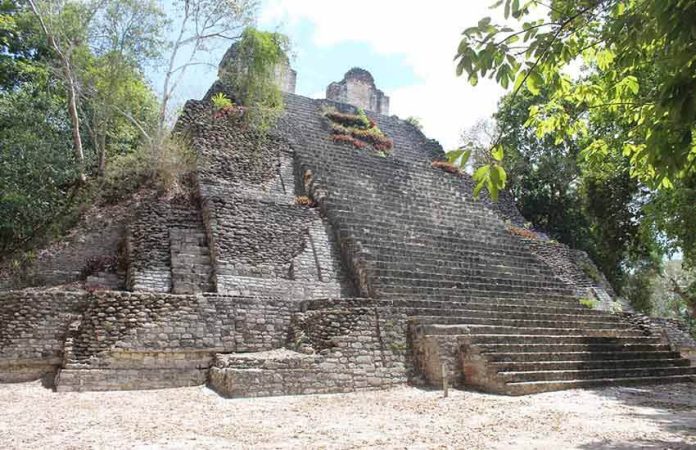If you are keen to see archaeological sites off the beaten path, then Dzibanché — called Dzibanché-Kinichná — is for you.
Dzibanché and Kinichná are two nearby sites that were part of a settlement of four groups.
While their location — around 81 kilometers from Chetumal (off Highway 186) — is not the most convenient to visit, you will not regret seeing the beautiful structures here. The pyramid in Kinichná is a key highlight.
You can combine a visit to Dzibanché with a trip to several archaeological sites, including Kohunlich and Oxtankah. We visited the sites from Bacalar.
According to the National Institute of Anthropology and History (INAH), Dzibanché was discovered and named by Thomas Gann, a British military doctor and archaeology enthusiast who visited the site in 1927.

Dzibanché is Mayan for “writing on wood,” referring to the wooden lintel with glyphs that was in one of the site’s temples. According to INAH, the settlement dates to around 300 B.C. and lasted until A.D. 1400–1550.
Only two of the settlement’s four groups — Dzibanché (also called the Main Group) and Kinichná — are open to visitors. Ancient Maya white roads (raised roads) connect these groups.
Notably, INAH says that Dzibanché is believed to have once been a capital of the powerful Kaan (Kaanu’l) dynasty, also called the Snake dynasty, who ruled in Calakmul.
Expect to spend a few hours exploring both sites. You can climb many structures, but there are steep steps, so take good care.
Once you enter the Dzibanché group, you will come across the Temple of the Lintels, a pyramid base with a temple on top. The wooden lintel that inspired the site’s name was found here.
The pyramid’s platform has characteristics resembling an architectural style from Teotihuacán in central Mexico.
Next, you can walk to Plaza Gann, named after the man who discovered the site.
West of the plaza is an interesting structure called the Temple of the Captives, which has a pyramid platform and a temple on top. You can observe the remains of a stucco mask on this structure.
Don’t forget to look out for the glyphs on this building’s stairway. INAH says the stairway records the war victories of a Kaan ruler, and that the glyphs include images of prisoners and related text.
North of the Gann Plaza is the Temple of the Toucans. It has a platform with a central stairway thought to have been used as seats to watch ceremonies in the plaza. You can see remains of stone blocks on this building that once had stucco masks.
A notable building in this area is the Temple of the Cormorants, the tallest on the site. It has a pyramidal base with a temple on top.
Multiple chambers were found within the platform, and one contained remains of what was called the “Lord of Dzibanché” with a rich offering, according to INAH. Make time to see the remains of reliefs on this building.

From here, you can climb up to the adjoining plaza on a higher level called Plaza Xibalbá. According to ancient Maya beliefs, Xibalbá was the underworld.
While the Temple of the Cormorants borders the west of the Plaza Xibalbá, toward the east is a building called the Temple of the Owl. INAH says that a woman with a notable offering was found buried here.
North and south of the plaza are palace structures built on platforms that are also worth seeing. There are other structures, including unexcavated mounds to see in the Dzibanché group.
Next, visit the Kinichná group, around two kilometers away.
Kinichná is Mayan for “House of the Sun.” The site has a gigantic pyramid called the Acropolis, which resembles an ancient version of a modern skyscraper. You can only see part of the pyramid from its base, but you can climb it to explore the different levels.
The first level above the pyramid’s base, called Level B, has two structures on each side with temples on top. The second level, called Level C, also has two temples on each side, and in the center are steps that lead to an upper temple.
This building once had stucco decorations and a figure of the Maya sun god, Kinich Ahau. Burials with offerings were discovered in this temple, which had included some of the best jade items found in the region, says INAH. You will not tire of the breathtaking views from this magnificent pyramid’s summit.
Kinichná has other unexcavated mounds. While exploring Dzibanché and Kinichná, keep an eye out for monkeys and different varieties of birds. The natural surroundings make the visit less tiring despite the region’s hot climate.
If you still have time after exploring, visit the Maya site of Kohunlich, around a 45- minute drive away.
Thilini Wijesinhe, a financial professional turned writer and entrepreneur, moved to Mexico in 2019 from Australia. She writes from Mérida, Yucatán. Her website can be found at https://momentsing.com/
